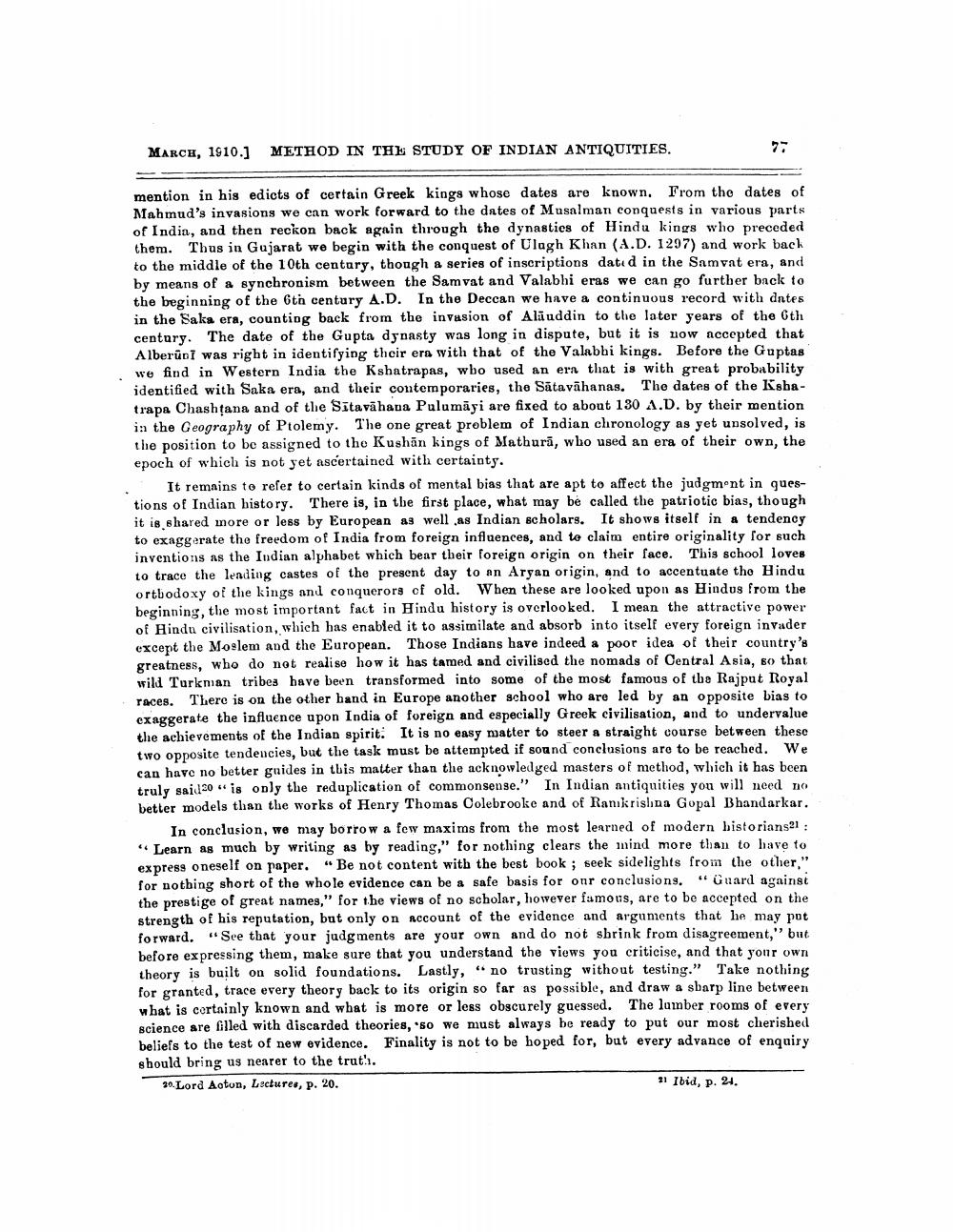________________
MARCH, 1910.] METHOD IN THE STUDY OF INDIAN ANTIQUITIES.
mention in his edicts of certain Greek kings whose dates are known. From the dates of Mahmud's invasions we can work forward to the dates of Musalman conquests in various parts of India, and then reckon back again through the dynastics of Hindu kings who preceded them. Thus in Gujarat we begin with the conquest of Ulagh Khan (A.D. 1297) and work back to the middle of the 10th century, though a series of inscriptions dated in the Samvat era, and by means of a synchronism between the Samvat and Valabhi eras we can go further back to the beginning of the 6th century A.D. In the Deccan we have a continuous record with dates. in the Saka era, counting back from the invasion of Alauddin to the later years of the 6th century. The date of the Gupta dynasty was long in dispute, but it is now accepted that Alberuni was right in identifying their era with that of the Valabhi kings. Before the Guptas we find in Western India the Kshatrapas, who used an era that is with great probability identified with Saka era, and their contemporaries, the Satavahanas. The dates of the Kshatrapa Chashṭana and of the Sitavahana Pulumayi are fixed to about 130 A.D. by their mention in the Geography of Ptolemy. The one great problem of Indian chronology as yet unsolved, is the position to be assigned to the Kushan kings of Mathura, who used an era of their own, the epoch of which is not yet ascertained with certainty.
77
It remains to refer to certain kinds of mental bias that are apt to affect the judgment in questions of Indian history. There is, in the first place, what may be called the patriotic bias, though it is shared more or less by European as well as Indian scholars. It shows itself in a tendency to exaggerate the freedom of India from foreign influences, and to claim entire originality for such inventions as the Indian alphabet which bear their foreign origin on their face. This school loves to trace the leading castes of the present day to an Aryan origin, and to accentuate the Hindu orthodoxy of the kings and conquerors of old. When these are looked upon as Hindus from the beginning, the most important fact in Hindu history is overlooked. I mean the attractive power of Hindu civilisation, which has enabled it to assimilate and absorb into itself every foreign invader except the Moslem and the European. Those Indians have indeed a poor idea of their country's greatness, who do not realise how it has tamed and civilised the nomads of Central Asia, so that wild Turkman tribes have been transformed into some of the most famous of the Rajput Royal races. There is on the other hand in Europe another school who are led by an opposite bias to exaggerate the influence upon India of foreign and especially Greek civilisation, and to undervalue the achievements of the Indian spirit. It is no easy matter to steer a straight course between these two opposite tendencies, but the task must be attempted if sound conclusions are to be reached. We can have no better guides in this matter than the acknowledged masters of method, which it has been truly said20is only the reduplication of commonsense." In Indian antiquities you will need no better models than the works of Henry Thomas Colebrooke and of Ranikrishna Gopal Bhandarkar.
In conclusion, we may borrow a few maxims from the most learned of modern historians21: "Learn as much by writing as by reading," for nothing clears the mind more than to have to express oneself on paper. "Be not content with the best book; seek sidelights from the other," for nothing short of the whole evidence can be a safe basis for our conclusions. "Guard against the prestige of great names," for the views of no scholar, however famous, are to be accepted on the strength of his reputation, but only on account of the evidence and arguments that he may put forward. "See that your judgments are your own and do not shrink from disagreement," but before expressing them, make sure that you understand the views you criticise, and that your own theory is built on solid foundations. Lastly, "no trusting without testing." Take nothing for granted, trace every theory back to its origin so far as possible, and draw a sharp line between what is certainly known and what is more or less obscurely guessed. The lumber rooms of every science are filled with discarded theories, so we must always be ready to put our most cherished beliefs to the test of new evidence. Finality is not to be hoped for, but every advance of enquiry should bring us nearer to the truth.
20. Lord Aoton, Lectures, p. 20.
21 Ibid, p. 24.




